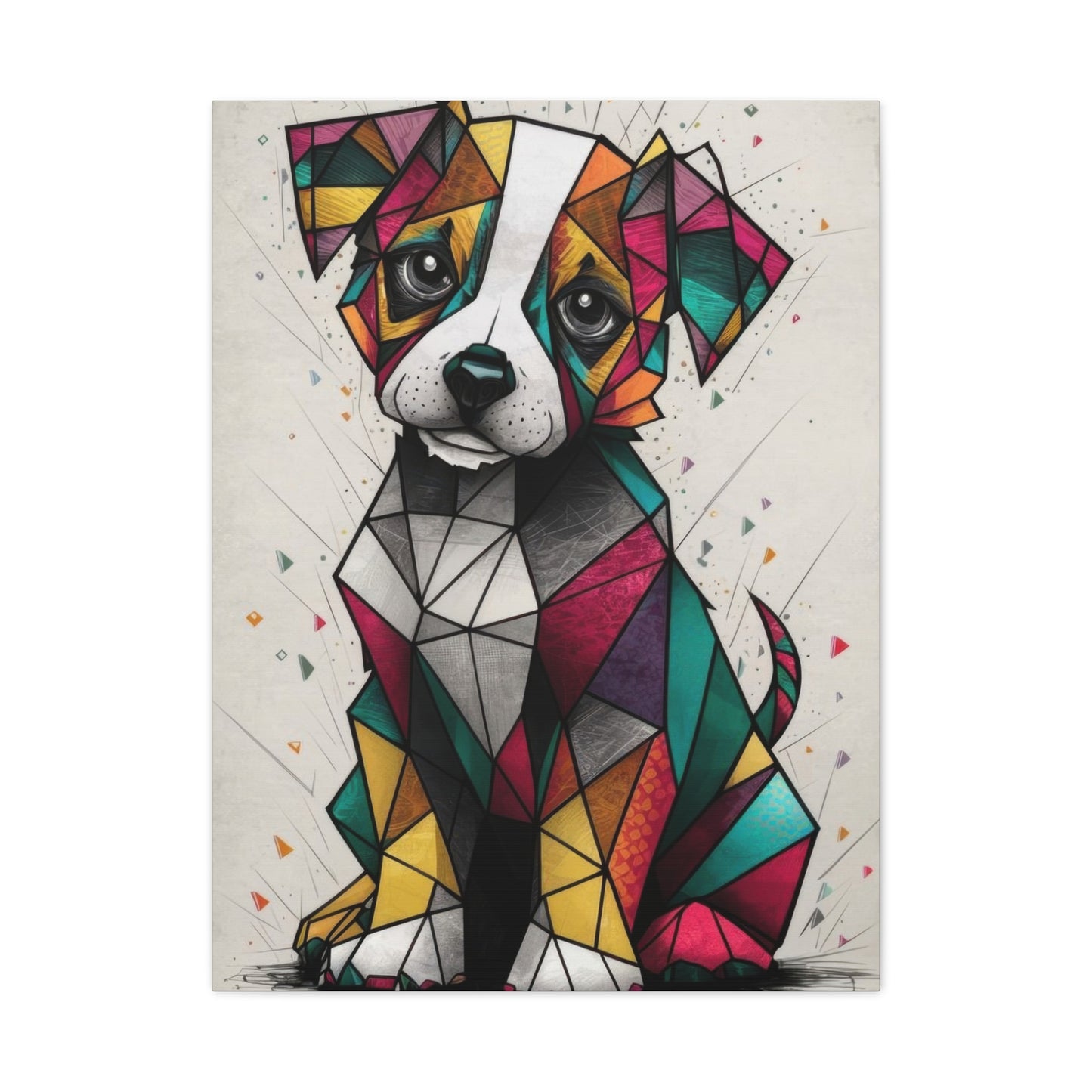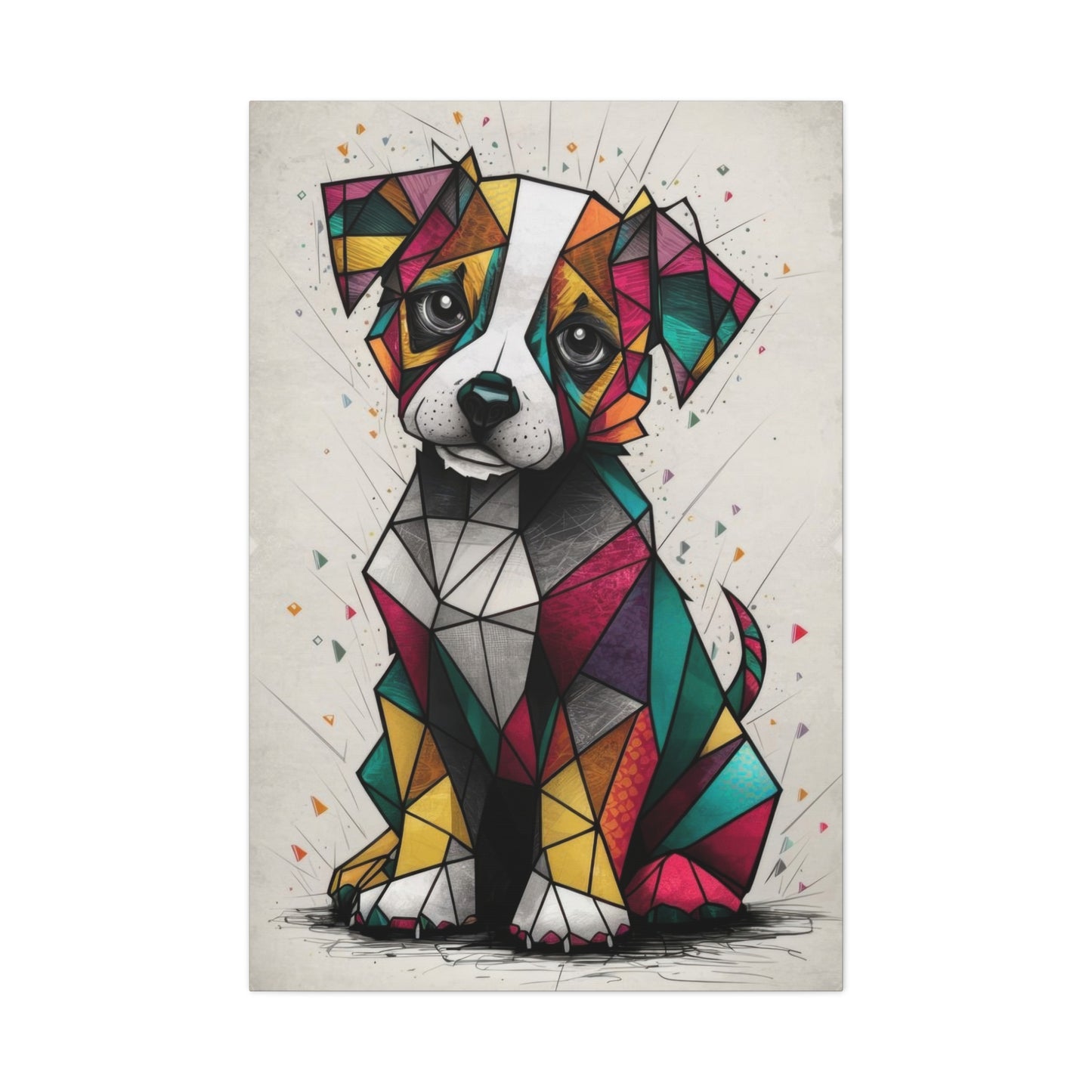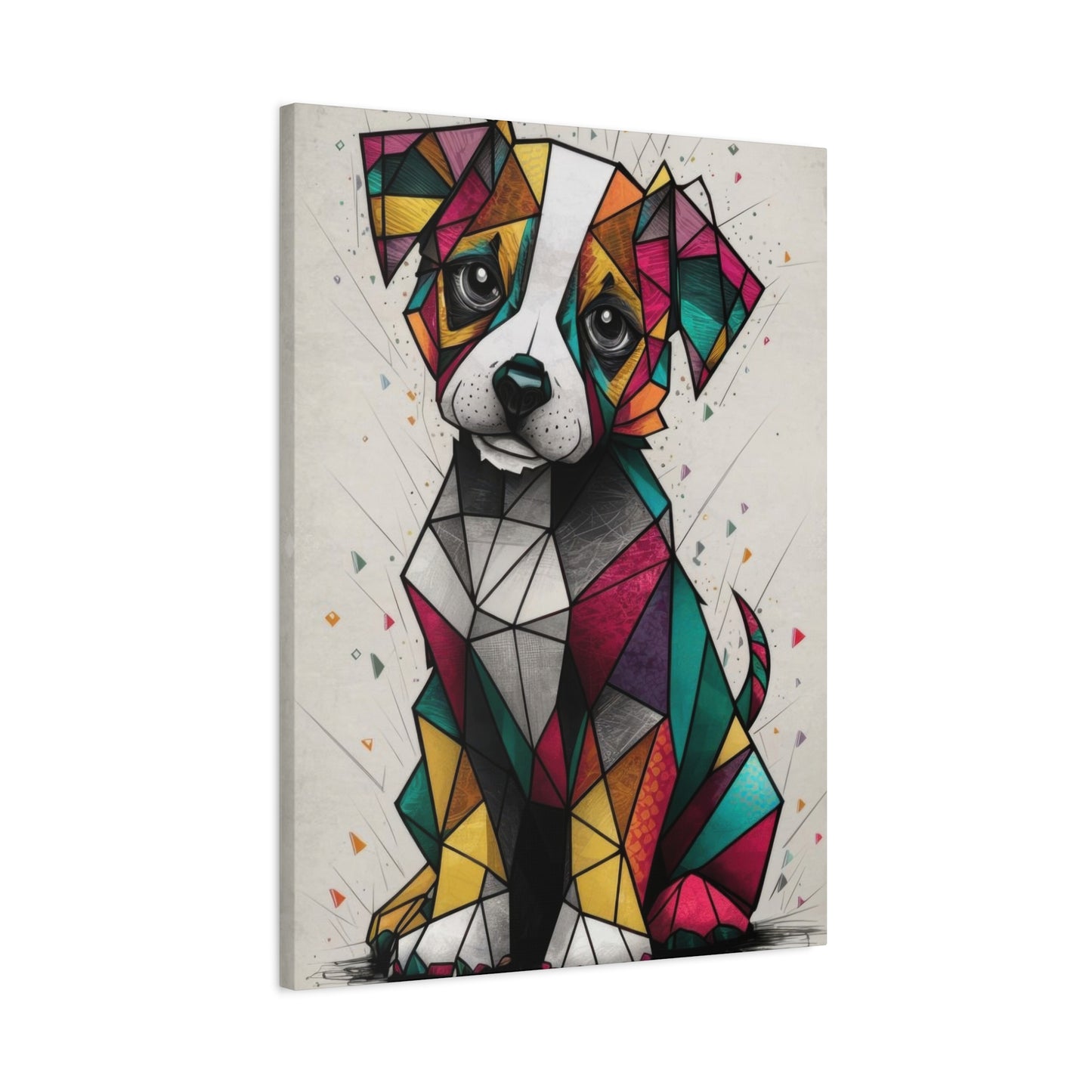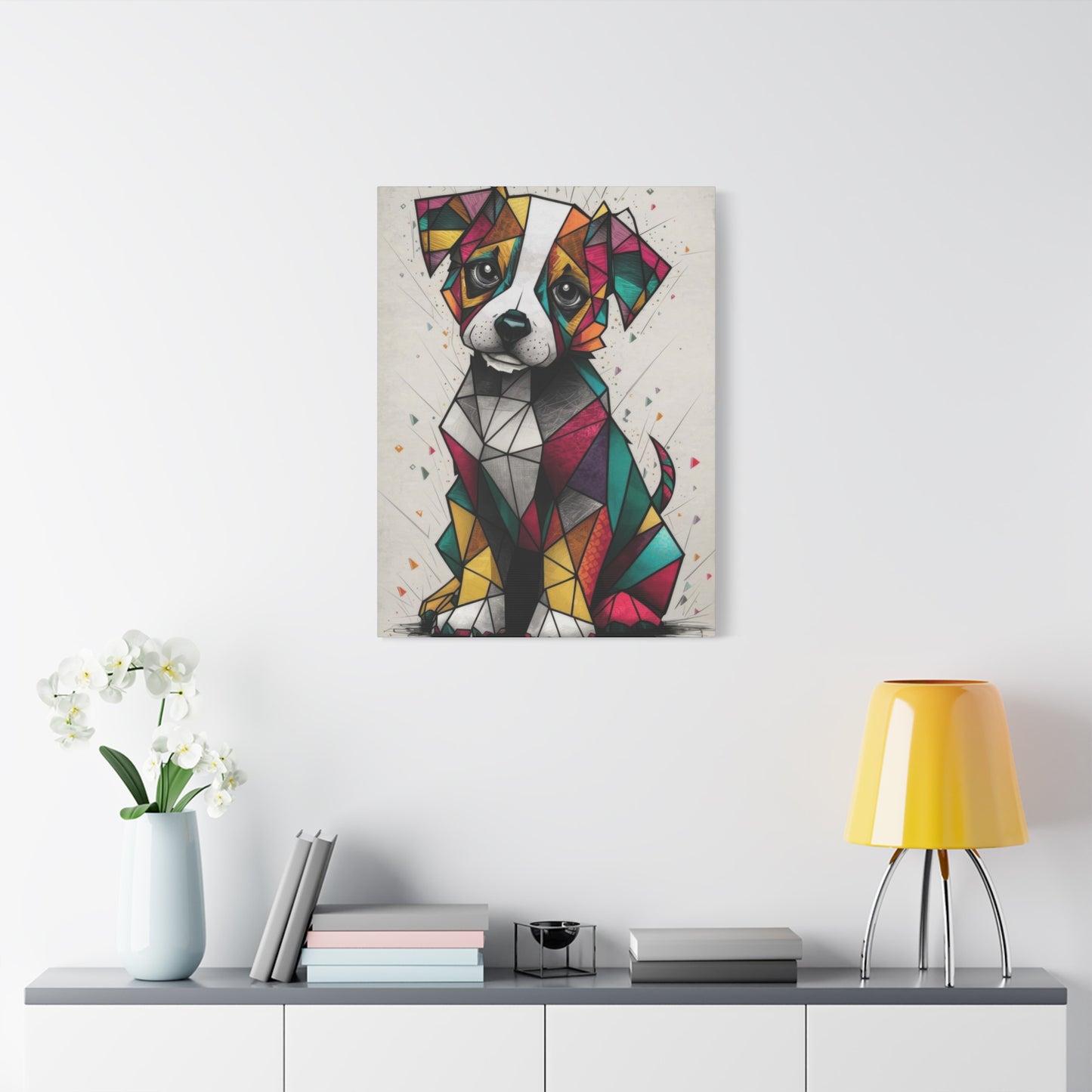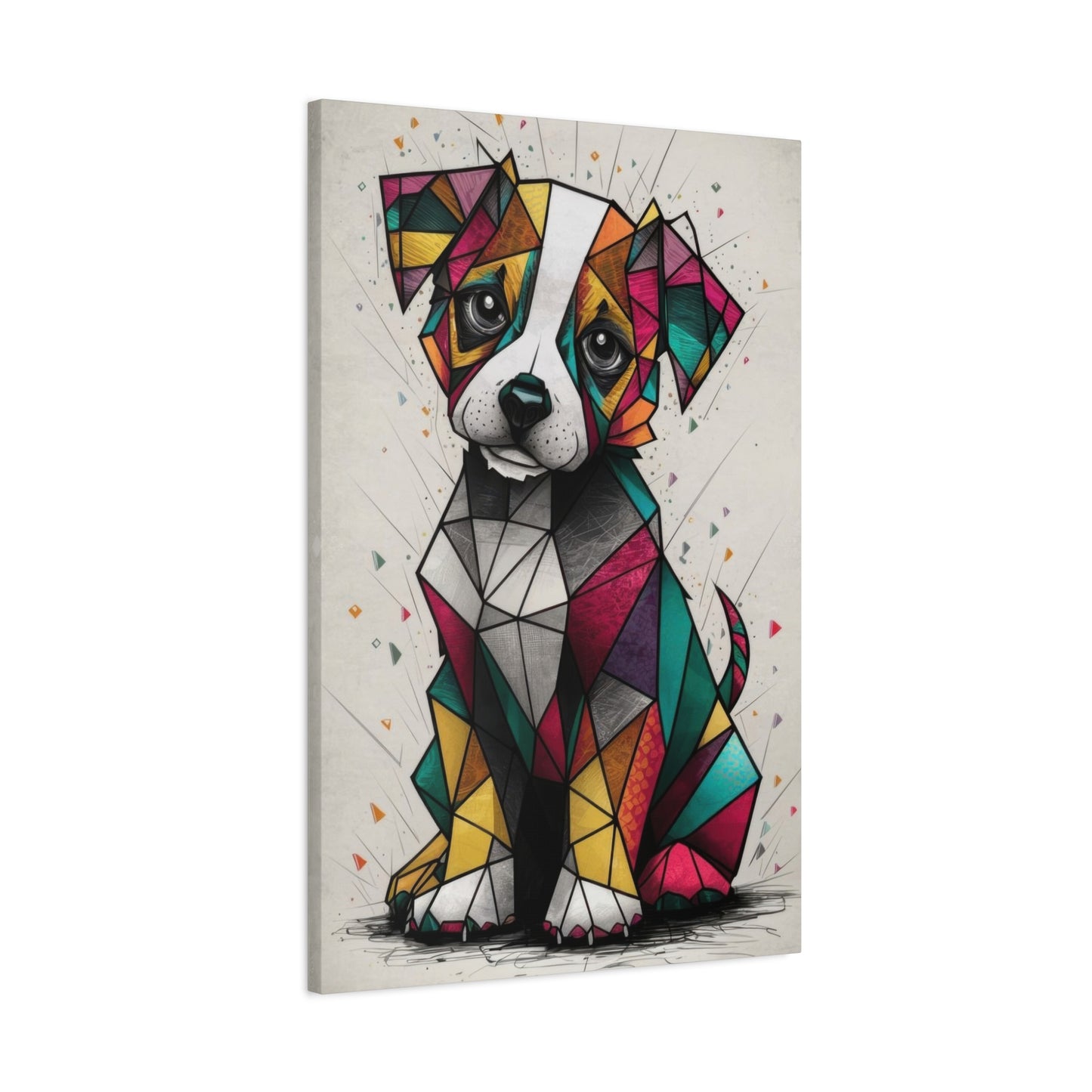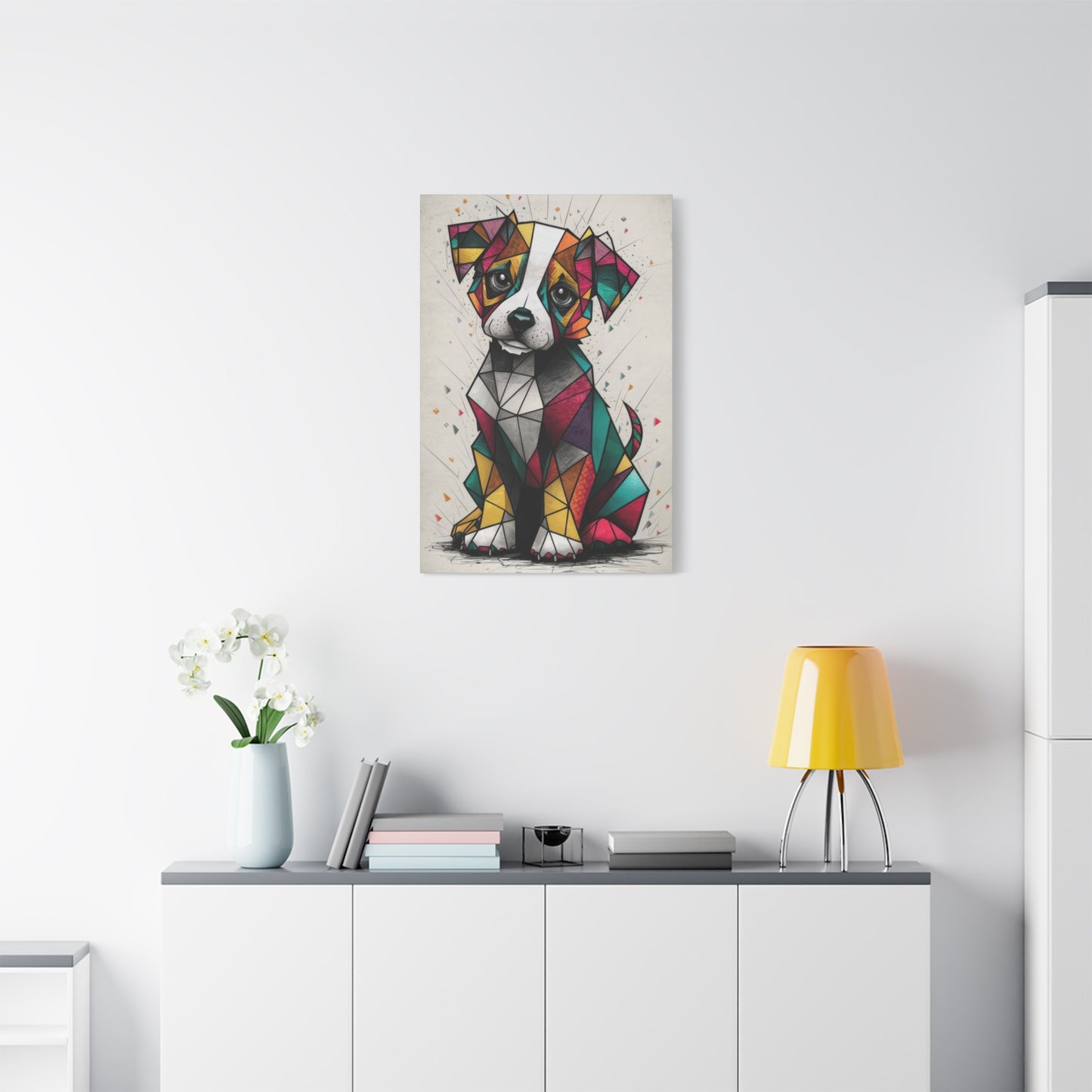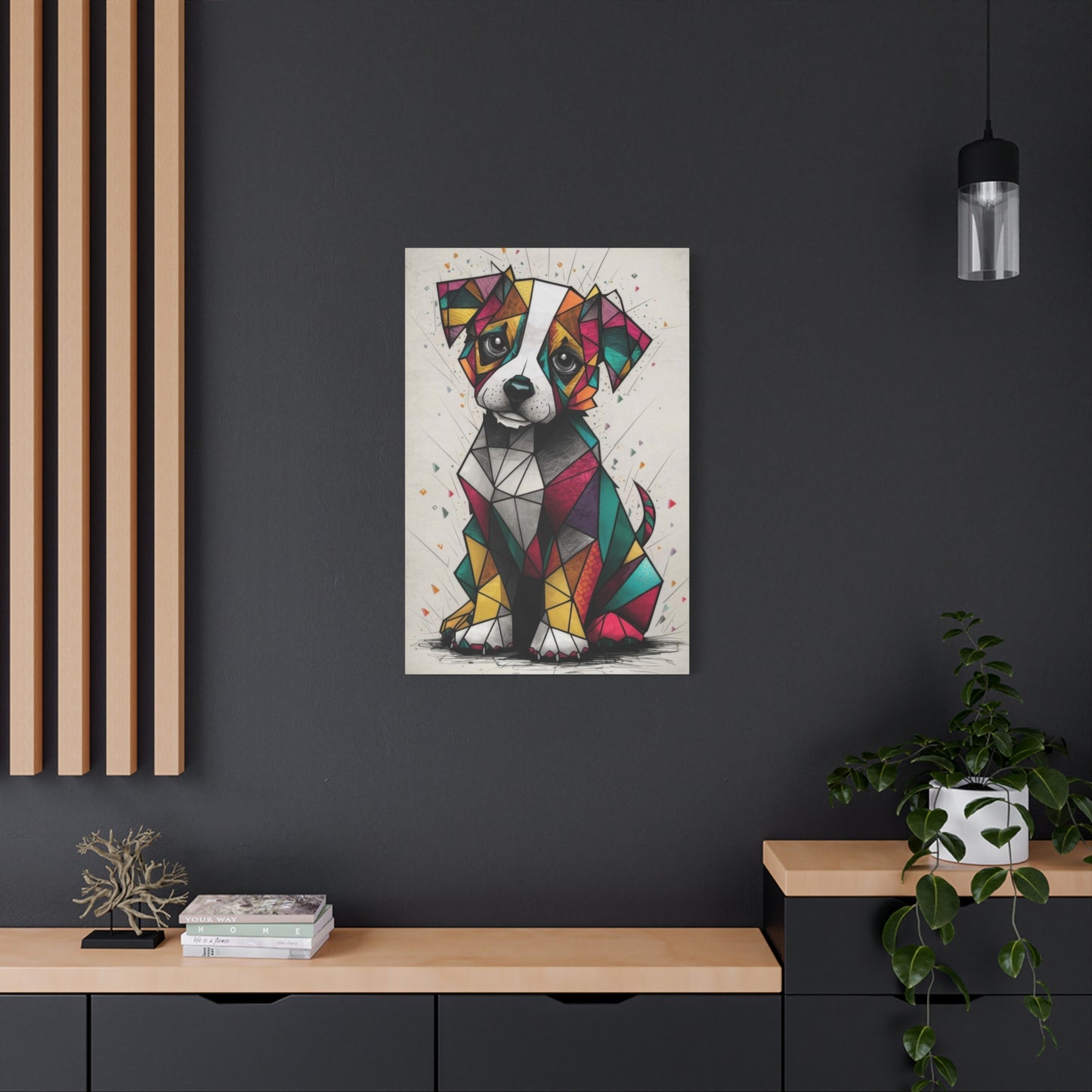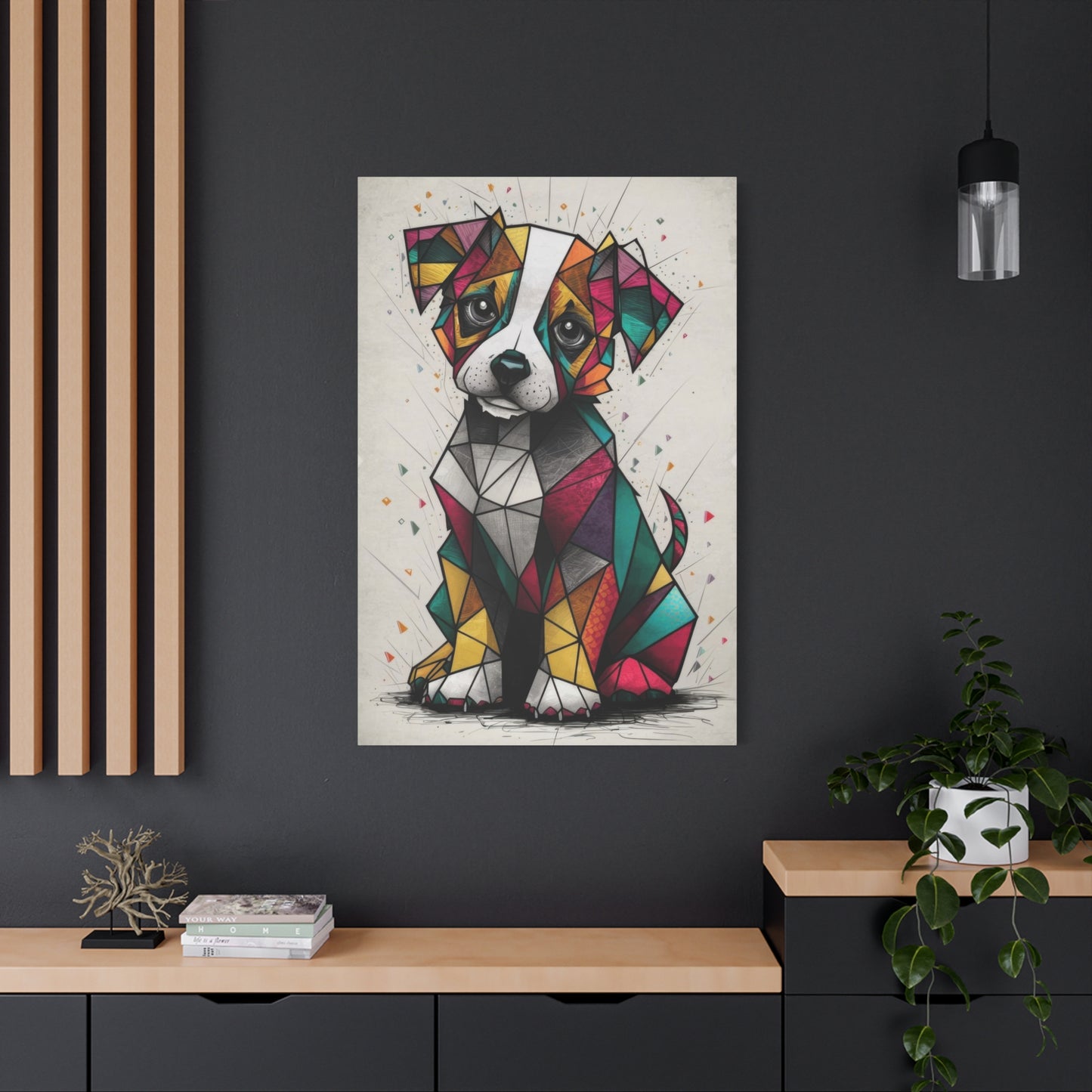Whimsical Geometry: Exploring the Charm of Cute Dog Cubism Wall Art
The world of contemporary interior design has witnessed a remarkable transformation in recent years, with artistic interpretations of beloved pets taking center stage in home decoration trends. Among the most captivating developments is the emergence of geometric style artwork featuring man's best friend, creating a perfect fusion of classical artistic movements and modern aesthetic sensibilities. This revolutionary approach to decorating living spaces has captured the hearts of art enthusiasts and pet lovers alike, offering a fresh perspective on how we celebrate our furry companions through visual art.
The geometric interpretation of canine subjects represents more than just a decorating trend; it embodies a sophisticated understanding of how abstract forms can capture the essence and personality of our beloved pets. This artistic style breaks down the organic shapes of dogs into angular planes, geometric patterns, and bold color combinations, creating visually striking pieces that command attention while maintaining an emotional connection to the subject matter. The result is artwork that transcends traditional pet portraiture, offering viewers a unique lens through which to appreciate both artistic innovation and the enduring bond between humans and their canine companions.
As homeowners increasingly seek distinctive ways to personalize their living environments, geometric style canine artwork has emerged as a versatile solution that complements various interior design approaches. Whether adorning the walls of a minimalist modern apartment, adding character to a contemporary office space, or bringing warmth to a traditional family home, these artistic interpretations offer flexibility and visual interest that few other decorative elements can match. The timeless appeal of geometric abstraction combined with the universal love for dogs creates artwork that resonates across generations and design preferences.
Understanding the Geometric Artistic Movement and Its Application to Animal Subjects
The geometric artistic movement emerged in the early twentieth century as a revolutionary departure from traditional representational art. This groundbreaking approach sought to deconstruct natural forms into their most basic geometric components, challenging viewers to see familiar subjects through an entirely new visual framework. Artists working within this movement believed that by breaking down complex organic shapes into simplified geometric forms, they could reveal the underlying structure and essence of their subjects in ways that traditional representation could not achieve.
When applied to animal subjects, particularly dogs, this geometric approach offers unique opportunities for artistic expression. The familiar features of canine faces, the curves of their bodies, and the expressive nature of their postures become transformed into angular planes, intersecting shapes, and bold color blocks. This transformation does not diminish the recognizable qualities of the subject; rather, it enhances them by stripping away unnecessary details and focusing on the fundamental characteristics that make each breed and individual dog distinctive.
The application of geometric principles to canine portraiture requires a deep understanding of both the artistic movement's theoretical foundations and the anatomical and behavioral characteristics of dogs. Artists must carefully study their subjects, identifying the key features that define a particular breed or capture a specific personality. These observations then inform the creative process of deconstructing the subject into geometric components while maintaining the essential qualities that make the image recognizable and emotionally resonant.
The color palettes employed in geometric canine artwork often draw inspiration from both the natural coloring of different dog breeds and the bold, expressive color theories developed by early geometric artists. Some pieces maintain realistic color schemes, using geometric forms to reinterpret natural coat patterns and markings. Others embrace more experimental approaches, employing unexpected color combinations that create visual drama and emotional impact. This flexibility in color application allows geometric canine artwork to adapt to various interior design schemes and personal preferences.
The geometric interpretation of dogs also offers practical advantages for contemporary interior design. The clean lines and structured composition of geometric artwork integrate seamlessly with modern architectural elements and contemporary furniture designs. The bold, graphic quality of these pieces ensures they remain visible and impactful even in larger spaces or when viewed from a distance. Additionally, the abstract nature of geometric representation allows these artworks to transcend specific trends, maintaining their visual appeal and relevance across changing design fashions.
Design Principles for Creating Visually Striking Geometric Canine Artwork
The creation of compelling geometric canine artwork requires mastery of fundamental design principles that govern visual composition, balance, and aesthetic impact. Artists working in this style must understand how to effectively deconstruct organic canine forms into geometric elements while maintaining compositional harmony and visual interest. The most successful pieces demonstrate sophisticated application of these principles, resulting in artwork that appears both structured and dynamic, abstract yet recognizable, bold yet harmonious.
Compositional balance represents a critical consideration in geometric dog artwork. Artists must carefully distribute visual weight across the canvas, ensuring that no single area overwhelms the composition while maintaining sufficient focal points to guide viewer attention. This balance can be achieved through symmetrical arrangements that create formal, stable compositions, or through asymmetrical designs that generate more dynamic, energetic visual experiences. The choice between symmetrical and asymmetrical composition often relates to the personality or breed characteristics the artist wishes to emphasize, with dignified breeds lending themselves to more formal arrangements and energetic breeds inspiring more dynamic compositions.
The principle of contrast functions as a powerful tool in geometric canine artwork, creating visual interest and helping define the various geometric elements that comprise the composition. Contrast can be achieved through multiple means including color relationships, value differences, textural variations, and scale relationships between different geometric shapes. Effective use of contrast ensures that individual geometric elements remain distinct and readable while contributing to the overall cohesiveness of the composition. High contrast compositions create bold, dramatic statements suitable for larger spaces or modern interiors, while lower contrast approaches yield more subtle, sophisticated results appropriate for calmer, more contemplative environments.
Rhythm and repetition play essential roles in successful geometric dog portraits, establishing visual patterns that unify the composition and create a sense of movement across the picture plane. Geometric shapes naturally lend themselves to rhythmic arrangements, with repeated triangles, rectangles, or circles creating visual beats that lead the eye through the composition. Artists skillfully employ rhythm and repetition to suggest movement, energy, or the textural qualities of fur and other physical characteristics. The careful modulation of repeated elements prevents monotony while maintaining compositional unity, demonstrating the artist's command of this fundamental design principle.
Scale relationships between geometric elements significantly impact the overall effectiveness of canine artwork. The juxtaposition of large and small geometric shapes creates visual hierarchy, guiding viewer attention to focal points while maintaining interest throughout the composition. In dog portraits, artists typically emphasize facial features through larger, more prominent geometric forms, ensuring that the expressive qualities of eyes, nose, and mouth remain recognizable and emotionally resonant despite geometric abstraction. Supporting elements like ears, body, and background receive treatment through smaller or more subdued geometric forms that complement rather than compete with primary focal areas.
Color harmony represents another crucial design principle in geometric canine artwork. Artists must carefully select and arrange colors to create cohesive visual statements that enhance rather than distract from the geometric composition. Color schemes might be analogous, using colors adjacent on the color wheel to create harmonious, unified effects, or complementary, employing opposite colors to generate visual excitement and dynamic tension. Triadic color schemes, utilizing three evenly spaced colors around the color wheel, offer another approach that provides visual interest while maintaining balance. The choice of color scheme profoundly influences the mood and character of the finished artwork, making color selection a critical component of the creative process.
Unity and variety work in tandem to create geometric dog artwork that feels both cohesive and interesting. Unity ensures that all elements of the composition relate to one another, creating a sense of wholeness and completeness. This can be achieved through consistent use of geometric forms, limited color palettes, or recurring visual motifs. Variety prevents the composition from becoming monotonous by introducing contrasting elements, unexpected color choices, or variations in geometric forms. The most successful geometric canine artwork strikes an effective balance between unity and variety, feeling coordinated without being predictable, interesting without being chaotic.
Different Styles and Approaches Within Geometric Canine Wall Decoration
The broad category of geometric canine artwork encompasses numerous distinct styles and approaches, each offering unique aesthetic qualities and visual characteristics. Understanding these different styles helps viewers and collectors identify works that align with their personal preferences and interior design needs. The diversity within geometric dog art ensures that this artistic approach can satisfy a wide range of tastes while maintaining its fundamental characteristics of geometric abstraction and canine subjects.
Angular geometric styles employ sharp, crisp lines and clearly defined shapes to construct canine images from geometric forms. This approach often features triangles, rectangles, and polygons arranged in precise configurations that create recognizable dog portraits through careful placement and color selection. The hard-edged quality of angular geometric art creates a modern, sophisticated aesthetic that works particularly well in contemporary interiors with clean lines and minimalist furnishings. The precision and structure of angular geometric pieces convey a sense of order and intentional design that appeals to viewers who appreciate clarity and definition in their artwork.
Softer geometric approaches incorporate curved lines and organic shapes alongside traditional geometric forms, creating a more fluid interpretation of geometric principles. These pieces might feature rounded triangles, circular elements, or flowing curves that suggest the natural contours of canine anatomy while maintaining geometric abstraction. The softer approach to geometric dog art creates a more accessible, approachable aesthetic that works well in traditional or transitional interiors where purely angular geometric art might feel too stark or modern. This style successfully bridges the gap between geometric abstraction and more representational approaches, making it appealing to viewers who appreciate geometric design but prefer softer, more organic visual qualities.
Faceted geometric styles take inspiration from three-dimensional forms, representing canine subjects as collections of angular facets that suggest dimensional depth and volumetric form. This approach creates the illusion that the dog portrait has been constructed from folded paper or carved from crystalline material, with each facet catching light differently and contributing to the overall dimensional quality of the image. Faceted geometric dog art displays particular visual impact, as the dimensional illusion creates dynamic compositions that appear to change as viewing angles and lighting conditions shift. This style works exceptionally well in spaces where artwork receives varied lighting throughout the day, as changing light reveals different aspects of the faceted composition.
Low-poly geometric artwork represents a digital-age approach to geometric canine art, utilizing a limited number of polygons to construct dog images. This style emerged from computer graphics and three-dimensional modeling, where polygon count directly impacts rendering speed and complexity. Low-poly dog portraits embrace this limitation as an aesthetic choice, creating images from carefully placed triangular or polygonal shapes that capture essential canine features with minimal geometric elements. The minimalist quality of low-poly art appeals to contemporary sensibilities, creating clean, modern images that feel both technologically current and artistically sophisticated.
Mosaic-inspired geometric approaches draw on ancient artistic traditions, reimagining canine subjects as collections of small geometric tiles or tessellated patterns. This style creates richly detailed, complex compositions that reward close examination while maintaining visual impact from a distance. The repetitive quality of mosaic-like geometric patterns creates rhythmic visual experiences, with individual geometric tiles combining to form larger shapes and compositional elements. Mosaic-style geometric dog art works particularly well in larger formats, where the complexity and detail of the composition can be fully appreciated.
Gradient geometric styles incorporate smooth color transitions within geometric forms, creating softer, more nuanced color relationships than typical flat-color geometric approaches. This technique adds subtlety and sophistication to geometric compositions, allowing for more complex modeling of form and more nuanced emotional expressions. Gradient-enhanced geometric dog portraits might use color transitions to suggest dimensional form, indicate lighting effects, or create atmospheric qualities that add depth and interest to the composition. This approach appeals to viewers who appreciate geometric design but prefer more subtle, refined color treatments.
Mixed-media geometric approaches combine geometric dog imagery with other artistic techniques, materials, or stylistic elements. These hybrid works might incorporate textural elements, photographic components, or representational details alongside geometric abstraction, creating rich, layered compositions that offer multiple levels of visual engagement. Mixed-media geometric dog art pushes the boundaries of traditional geometric approaches, demonstrating how geometric principles can be integrated with other artistic methods to create innovative, contemporary artworks that defy simple categorization.
Selecting the Perfect Geometric Canine Artwork for Your Living Space
Choosing appropriate geometric dog artwork for specific interior spaces requires careful consideration of multiple factors including room size, existing decor, lighting conditions, and the emotional atmosphere you wish to create. The right artwork can transform a space, serving as a focal point that anchors the room's design while expressing personal style and creating visual interest. Understanding how to evaluate geometric canine artwork in relation to your specific space ensures satisfying results that enhance rather than compete with your existing interior design.
Scale considerations form the foundation of successful artwork selection. The relationship between artwork size and wall space significantly impacts visual effectiveness, with pieces that are too small appearing lost and insignificant, while oversized works can overwhelm a space. A general guideline suggests that artwork should occupy roughly two-thirds to three-quarters of the available wall space, though this rule can be adjusted based on specific circumstances and design goals. For geometric dog portraits, which typically feature bold shapes and strong visual presence, slightly smaller proportions may prove more effective than with softer, more subtle artwork styles.
The color relationships between geometric canine artwork and existing room elements profoundly influence overall aesthetic harmony. Artwork colors should relate to the room's color scheme, either complementing existing hues through analogous relationships or creating intentional contrast through complementary pairings. Consider whether you want the geometric dog portrait to blend harmoniously with existing colors or serve as an accent piece that introduces new color energy into the space. Rooms dominated by neutral tones offer opportunities for geometric artwork with bold, saturated colors to serve as dramatic focal points, while spaces with existing strong colors may benefit from more restrained artwork palettes that support rather than compete with the established color scheme.
Stylistic compatibility between geometric dog artwork and existing furnishings ensures cohesive interior design. Angular geometric pieces with sharp lines and precise forms naturally complement modern, contemporary, or minimalist interiors featuring clean lines and simple forms. Softer geometric approaches with curved elements and organic shapes work well in transitional spaces that blend traditional and contemporary elements. The key lies in identifying connecting visual elements between the artwork and existing furnishings, whether through shared geometric motifs, color relationships, or overall aesthetic sensibility.
Lighting conditions in the intended display location significantly affect how geometric canine artwork appears and functions within the space. Natural lighting reveals colors most accurately but changes throughout the day as sun position shifts, potentially creating different moods and visual effects at various times. Artificial lighting offers more control but can affect color perception depending on the type of bulbs and fixtures used. Consider both natural and artificial lighting when selecting geometric dog artwork, ideally evaluating pieces under lighting conditions similar to those in the intended display location. Faceted or dimensional geometric styles prove particularly sensitive to lighting variations, creating different visual effects as light angles change throughout the day.
The emotional atmosphere you wish to create in the space should inform geometric canine artwork selection. Energetic, playful geometric dog portraits with bright colors and dynamic compositions suit spaces intended for activity and social interaction like family rooms, playrooms, or casual dining areas. More sophisticated, subdued geometric pieces with refined color palettes and balanced compositions work better in spaces intended for relaxation or contemplation such as bedrooms, studies, or formal living rooms. Consider the room's purpose and the feelings you want to evoke when selecting geometric artwork, ensuring the piece supports rather than contradicts the intended emotional atmosphere.
Personal connection to the artwork represents perhaps the most important selection criterion. Geometric dog portraits that resonate emotionally, remind you of beloved pets, or simply bring joy when viewed will provide lasting satisfaction regardless of technical design considerations. Trust your instinctive responses to potential artwork selections, recognizing that the emotional response to a piece indicates genuine connection that will sustain long-term appreciation. The most successful artwork selections combine thoughtful consideration of design principles with authentic emotional response, resulting in pieces that both function effectively within the space and provide personal meaning and enjoyment.
Color Theory Applications in Geometric Canine Artwork
Color selection and application in geometric dog artwork requires sophisticated understanding of color theory principles and their psychological and aesthetic effects. The colors chosen for geometric canine pieces profoundly impact their emotional resonance, visual impact, and compatibility with various interior design schemes. Artists working in geometric styles must consider not only the aesthetic properties of different colors but also their symbolic associations, emotional effects, and practical considerations regarding color harmony and contrast.
Primary colors including red, blue, and yellow form the foundation of color mixing and create bold, energetic geometric dog portraits with strong visual presence. These pure, unmixed hues generate maximum color intensity and create dynamic, attention-commanding compositions. Geometric canine artwork utilizing primary colors works particularly well in modern, minimalist interiors where the bold color statements complement clean lines and simple forms. The high contrast created by primary colors ensures visibility and impact even in larger spaces or when viewed from substantial distances, making primary color geometric pieces effective choices for prominent display locations.
Secondary colors created by mixing primary hues including orange, green, and purple offer slightly more complex color relationships while maintaining strong visual presence. These colors create harmonious relationships with their parent primary colors while introducing additional nuance and sophistication to geometric compositions. Orange combines red's energy with yellow's warmth, creating enthusiastic, friendly qualities appropriate for playful dog portraits. Green blends blue's calm with yellow's optimism, producing balanced, natural-feeling hues. Purple merges red's passion with blue's serenity, generating sophisticated, dignified effects suitable for more refined geometric interpretations.
Tertiary colors formed by mixing primary and secondary hues provide even greater subtlety and complexity in geometric dog artwork. These intermediate colors including red-orange, yellow-orange, yellow-green, blue-green, blue-purple, and red-purple offer expanded palette options that create sophisticated color harmonies. Tertiary colors allow artists to develop more nuanced color relationships that reference natural dog coat colors while maintaining the bold, graphic quality essential to geometric composition. The increased complexity of tertiary colors creates visual interest without overwhelming compositions with excessive variety.
Monochromatic color schemes utilizing various values and saturations of a single hue create unified, cohesive geometric dog portraits with sophisticated, refined qualities. This approach relies on value contrast and saturation differences rather than hue variety to create visual interest and define geometric forms. Monochromatic geometric canine artwork works exceptionally well in minimalist interiors where color restraint supports overall design goals. The limited palette focuses viewer attention on compositional elements, geometric form relationships, and the essential characteristics of the canine subject without the distraction of complex color interactions.
Analogous color schemes employing three to five adjacent colors from the color wheel create harmonious, unified geometric dog portraits with cohesive color relationships. This approach provides more color variety than monochromatic schemes while maintaining strong color harmony through the use of related hues. Warm analogous schemes using reds, oranges, and yellows create energetic, enthusiastic geometric dog portraits suitable for active spaces. Cool analogous palettes featuring blues, greens, and purples generate calm, sophisticated effects appropriate for more serene environments. Analogous color schemes offer flexibility for representing various dog coat colors while maintaining artistic coherence.
Complementary color schemes utilizing opposite colors from the color wheel create maximum color contrast and visual excitement in geometric canine artwork. The tension between complementary colors generates dynamic, energetic compositions with strong visual impact. This approach works particularly well in geometric styles where bold statements align with artistic goals. Common complementary pairings include blue and orange, red and green, and yellow and purple, each creating distinct emotional and aesthetic effects. The intensity of complementary contrast can be modulated by adjusting color saturation or value, creating more subtle relationships while maintaining the fundamental complementary structure.
Triadic color schemes employing three evenly spaced colors around the color wheel offer balanced variety in geometric dog portraits. This approach provides substantial color diversity while maintaining equilibrium through the equal spacing of selected hues. Triadic schemes create vibrant, cheerful compositions suitable for playful, energetic geometric dog interpretations. The primary triadic scheme of red, yellow, and blue creates the most intense color relationships, while secondary and tertiary triadic combinations offer more subtle variations. Successful triadic compositions typically designate one color as dominant while using the other two in supporting roles, creating hierarchy and preventing chaotic color competition.
Neutral color applications in geometric canine artwork create sophisticated, versatile pieces that integrate easily with diverse interior design schemes. Neutrals including black, white, gray, beige, and brown provide excellent background support for geometric compositions or can function as primary colors in more restrained, minimalist interpretations. Warm neutrals containing slight undertones of red, orange, or yellow create inviting, comfortable geometric dog portraits, while cool neutrals with blue or green undertones generate more contemporary, sophisticated effects. The versatility of neutral-dominated geometric artwork makes these pieces excellent investment choices for collectors who anticipate changing interior design schemes over time.
Breed-Specific Considerations in Geometric Dog Portraiture
Different dog breeds possess distinctive physical characteristics, proportions, and personality traits that influence how they translate into geometric artwork. Understanding breed-specific features helps artists create more recognizable and characterful geometric dog portraits while guiding collectors in selecting pieces that appropriately represent their favorite breeds. The geometric interpretation of breed characteristics requires careful observation and thoughtful abstraction to maintain recognition while achieving aesthetic goals of geometric design.
Long-snouted breeds including Greyhounds, Whippets, Collies, and German Shepherds present opportunities for elongated geometric forms and elegant linear compositions. The distinctive profile of these breeds with their extended muzzles and refined features translates naturally into angular geometric interpretations featuring triangular and rectangular forms. Artists working with long-snouted breeds can emphasize sleek, streamlined qualities through carefully arranged geometric elements that suggest speed, grace, and refinement. The proportional relationship between the long muzzle and other facial features becomes a key consideration in creating recognizable geometric portraits of these breeds.
Short-faced breeds such as Pugs, Bulldogs, Boston Terriers, and French Bulldogs require different geometric approaches that capture their compact, rounded facial structures and distinctive pushed-in features. These breeds challenge geometric artists to create effective compositions using rounder, more compact geometric forms that convey the breeds' characteristic appearance without losing the essential geometric aesthetic. The prominent eyes and expressive faces of short-nosed breeds provide focal points that anchor geometric compositions while their stocky, muscular bodies translate effectively into substantial, grounded geometric forms.
Large, majestic breeds including Great Danes, Mastiffs, Saint Bernards, and Newfoundlands inspire geometric interpretations that emphasize size, power, and dignified presence. Geometric portraits of these imposing breeds benefit from bold, substantial geometric forms and compositions that convey their impressive physical stature. Color choices often reflect the breeds' natural coat colors while potentially incorporating darker, more substantial hues that reinforce perceptions of size and strength. The noble bearing characteristic of many large breeds translates into balanced, symmetrical geometric compositions that convey dignity and gravitas.
Small companion breeds such as Chihuahuas, Yorkshire Terriers, Pomeranians, and Toy Poodles present opportunities for delicate, refined geometric interpretations that capture their diminutive size and often feisty personalities. Despite their small stature, these breeds possess outsized personalities that geometric artists can represent through dynamic compositions, bold color choices, and energetic geometric arrangements. The large eyes relative to overall head size characteristic of many small breeds creates natural focal points in geometric compositions, drawing viewer attention and creating emotional connection.
Working and sporting breeds including Labrador Retrievers, Golden Retrievers, Border Collies, and Australian Shepherds translate into geometric artwork emphasizing athletic build, intelligent expression, and energetic character. These breeds' well-proportioned features and balanced builds lend themselves to harmonious geometric compositions with clear structural organization. The alert, attentive expressions typical of working breeds can be captured through careful geometric rendering of eye position and ear placement, conveying the intelligence and awareness these breeds demonstrate.
Terrier breeds with their distinctive head shapes, alert expressions, and spirited personalities inspire geometric interpretations that capture their characteristic spunk and determination. Wire-haired terriers present particular interest for geometric treatment, as their textured coats can be suggested through varied geometric patterns and carefully arranged color relationships. The rectangular or square head shapes typical of many terrier breeds align naturally with geometric compositional principles, creating recognizable profiles through strategic arrangement of angular forms.
Long-haired breeds including Afghan Hounds, Maltese, Shih Tzus, and Yorkshire Terriers offer opportunities to represent flowing coat characteristics through geometric means. Artists interpret the flowing hair of these breeds through layered geometric shapes, graduated color transitions, or rhythmic geometric patterns that suggest movement and texture. The contrast between the geometric structure of the dog's underlying anatomy and the flowing quality of their coats creates interesting compositional tension that adds depth and interest to geometric portraits of long-haired breeds.
Spotted and uniquely marked breeds such as Dalmatians, Australian Cattle Dogs, and Catahoula Leopard Dogs provide built-in geometric patterns through their distinctive coat markings. These natural patterns integrate seamlessly with geometric artistic approaches, creating compositions where the dog's markings become integral compositional elements. Artists working with spotted breeds can emphasize the rhythmic quality of spot patterns through geometric abstraction while maintaining breed recognition through distinctive pattern arrangements and color relationships.
Integration of Geometric Canine Artwork with Various Interior Design Styles
Geometric dog artwork's versatility allows successful integration with diverse interior design styles ranging from ultra-modern to traditional approaches. Understanding how geometric canine pieces function within different design contexts helps homeowners and designers make informed selections that enhance rather than conflict with existing aesthetic directions. The key lies in recognizing connecting elements between geometric artwork characteristics and specific design style principles.
Modern interior design with its emphasis on clean lines, minimal ornamentation, and functional simplicity provides an ideal context for geometric dog artwork. The structured, angular quality of geometric compositions aligns perfectly with modern design principles, creating harmonious relationships between artwork and environment. Geometric canine pieces in modern spaces typically feature bold, saturated colors that provide contrast against neutral wall colors and simple furnishings. The graphic quality of geometric dog portraits functions as artistic focal points in modern interiors, adding visual interest and personal expression without introducing unnecessary complexity or clutter.
Contemporary interior design's eclectic, evolving nature welcomes geometric canine artwork as flexible decorative elements that bridge various influences and time periods. The current nature of geometric dog art aligns with contemporary design's forward-looking character while geometric principles' historical roots provide connection to artistic tradition. Contemporary spaces benefit from geometric canine artwork's ability to function as conversation pieces that demonstrate artistic awareness and sophisticated design sensibility. The wide variety of geometric styles and approaches allows selection of pieces that complement contemporary interiors' specific color schemes, forms, and atmospheric goals.
Minimalist interior design, with its radical reduction of elements to absolute essentials, accommodates geometric dog artwork as carefully selected focal points that justify their presence through visual impact and personal meaning. Minimalist spaces require geometric pieces with strong compositional clarity, refined color palettes, and exceptional execution that warrant their inclusion in deliberately sparse environments. Single large-scale geometric dog portraits often work better in minimalist contexts than multiple smaller pieces, maintaining the uncluttered visual environment central to minimalist principles while providing necessary artistic interest and emotional warmth.
Scandinavian interior design principles emphasizing simplicity, functionality, and connection to nature create welcoming contexts for geometric dog artwork. The clean lines and uncluttered compositions characteristic of Scandinavian design align naturally with geometric artistic approaches. Geometric canine pieces in Scandinavian interiors often feature softer color palettes incorporating whites, grays, and muted earth tones that complement the light, airy quality of Nordic design. The emphasis on craftsmanship and quality in Scandinavian design extends to artwork selection, favoring geometric dog portraits demonstrating skilled execution and thoughtful composition over purely decorative pieces.
Mid-century modern interior design with its organic forms, clean lines, and integration of nature references provides another compatible context for geometric canine artwork. The period's artistic experimentation and embrace of abstraction created environments receptive to geometric artistic approaches. Geometric dog portraits featuring the warm wood tones, oranges, teals, and mustard yellows popular in mid-century design integrate seamlessly into these spaces. The playful, optimistic quality of much mid-century design finds expression in geometric canine artwork's ability to balance sophisticated artistic technique with approachable, emotionally resonant subject matter.
Traditional interior design styles might initially seem incompatible with geometric dog artwork's modern aesthetic, yet thoughtful selection and presentation can create successful integration. Softer geometric approaches incorporating curved forms and more naturalistic color palettes bridge the gap between geometric abstraction and traditional design's preference for representational art. Ornate frames in traditional finishes like gilded wood or carved details provide transitional elements that help geometric canine artwork feel at home in traditional spaces. The key lies in identifying geometric pieces whose colors, scale, and overall character complement rather than fight against traditional design elements.
Transitional interior design deliberately blending traditional and contemporary elements creates ideal conditions for geometric dog artwork to function as bridge elements connecting different design influences. Geometric canine pieces in transitional spaces might feature classical framing combined with modern geometric imagery, or incorporate traditional color palettes rendered in contemporary geometric styles. The flexibility of transitional design allows experimentation with various geometric approaches, finding pieces that successfully honor both traditional comfort and contemporary innovation.
Eclectic interior design embracing diverse influences, periods, and styles welcomes geometric canine artwork as one element among many contributing to richly layered environments. The challenge in eclectic spaces lies not in making geometric dog art compatible with existing elements but rather in ensuring it contributes meaningfully to the overall composition without getting lost among competing visual elements. Bold, confident geometric pieces with strong color presence and clear compositional structure typically function most successfully in eclectic environments, maintaining visual presence among diverse decorative elements.
Creating Gallery Wall Arrangements Featuring Geometric Canine Artwork
Gallery wall compositions provide dynamic presentation options for geometric dog artwork, allowing multiple pieces to function together in creating unified visual statements larger than individual artworks could achieve alone. The structured, graphic quality of geometric canine pieces lends itself particularly well to gallery wall arrangements, as the geometric nature of the artwork helps organize diverse elements into cohesive presentations. Creating successful gallery walls requires careful planning, consideration of multiple design factors, and willingness to experiment with different arrangements before committing to final installation.
Grid arrangements represent the most structured approach to gallery wall composition, organizing geometric dog artworks in regular rows and columns with consistent spacing. This formal arrangement creates ordered, harmonious presentations that emphasize the collection as a unified whole rather than highlighting individual pieces. Grid gallery walls work particularly well with geometric canine artwork of similar sizes and complementary styles, creating rhythmic, pattern-like displays that feel intentional and designed. The consistent spacing typical of grid arrangements, usually two to three inches between pieces, creates visual breathing room while maintaining strong connection between individual artworks.
Salon-style gallery walls arrange geometric dog portraits in seemingly casual, organic compositions that fill wall space more completely than grid arrangements. This traditional approach to gallery display creates rich, layered presentations that reward close examination while maintaining overall visual coherence. Salon-style arrangements require careful attention to balance and spacing, ensuring that the apparently casual arrangement actually results from thoughtful planning. Begin with a central anchor piece, typically the largest or most visually significant geometric dog portrait, then build outward, adding pieces that balance visual weight while maintaining appropriate spacing and alignment relationships.
Linear gallery walls arrange geometric canine artwork along horizontal or vertical axes, creating streamlined presentations that work well in hallways, staircases, or above furniture pieces. Horizontal linear arrangements emphasize width and create grounding effects, working well above sofas, consoles, or dining tables. Vertical linear galleries draw the eye upward, creating height emphasis suitable for narrow wall spaces or areas with high ceilings. Linear arrangements benefit from maintaining consistent alignment along one edge while allowing the opposite edge to create more varied, interesting profiles.
Symmetrical gallery walls create balanced, formal presentations by arranging geometric dog portraits in mirror-image configurations. This approach works particularly well in traditional or formal spaces where balanced composition supports overall design goals. Symmetrical arrangements require careful attention to visual weight, ensuring that pieces on either side of the central axis balance each other in size, color intensity, and visual presence. The central focal point of symmetrical gallery walls typically features the most significant or visually commanding piece, with supporting artworks arranged symmetrically on either side.
Asymmetrical gallery wall compositions create more dynamic, casual presentations through intentionally unbalanced arrangements that nevertheless achieve visual equilibrium. This approach allows greater flexibility in combining geometric dog artworks of different sizes, styles, and orientations. Asymmetrical galleries require careful attention to visual weight distribution, balancing larger or more visually heavy pieces on one side with groups of smaller pieces or empty space on the other. The resulting compositions feel energetic and contemporary, suitable for modern or casual interior environments.
Geometric gallery wall arrangements echo the geometric nature of the canine artwork itself, organizing pieces into triangular, circular, or other geometric configurations. This self-referential approach creates sophisticated, intentional presentations that demonstrate design awareness and artistic sensibility. Geometric arrangements might position pieces to suggest circular compositions radiating from central focal points, triangular configurations creating dynamic upward or downward movement, or rectangular arrangements emphasizing horizontal or vertical emphasis. The geometric organization helps diverse pieces function together cohesively while creating interesting compositional structures.
The Role of Geometric Canine Artwork in Commercial and Office Spaces
Geometric dog artwork extends beyond residential applications to function effectively in commercial and professional environments including offices, retail spaces, hospitality venues, and healthcare facilities. The professional presentation and contemporary aesthetic of geometric canine pieces make them suitable for business contexts while their emotional warmth and accessibility prevent spaces from feeling cold or impersonal. Understanding how geometric dog artwork functions in commercial applications helps businesses select pieces that support brand identity, enhance employee satisfaction, and create positive impressions on clients and visitors.
Corporate office environments benefit from geometric canine artwork's ability to humanize professional spaces while maintaining appropriate sophistication and polish. The structured, intentional quality of geometric design aligns with corporate values of organization and professionalism while the approachable subject matter of dogs creates emotional warmth that softens potentially sterile business environments. Reception areas and lobbies provide particularly suitable locations for large-scale geometric dog portraits that create memorable first impressions and communicate company personality. Conference rooms and collaboration spaces benefit from geometric canine artwork that stimulates creativity and conversation while maintaining professional appropriateness.
Veterinary clinics and animal-related businesses find geometric dog artwork ideally suited to their specialized needs, celebrating their canine focus while demonstrating artistic sophistication that distinguishes them from competitors. The contemporary aesthetic of geometric dog portraits positions veterinary practices as modern, forward-thinking businesses committed to current best practices. Waiting rooms benefit from geometric canine artwork that provides visual interest and emotional comfort to clients awaiting appointments with their pets. Examination rooms and treatment areas can incorporate geometric dog portraits that create calming, positive environments supporting animal welfare and stress reduction.
Retail environments particularly pet supply stores, grooming salons, and dog-related boutiques use geometric canine artwork to reinforce brand identity and create distinctive shopping experiences. The bold, graphic quality of geometric dog portraits creates visual impact that attracts attention and distinguishes retail spaces from competitors. Large-scale geometric canine installations function as Instagram-worthy focal points that encourage social media sharing, extending marketing reach beyond physical store boundaries. The contemporary aesthetic of geometric dog artwork appeals to design-conscious consumers who value style alongside functionality in their pet-related purchases.
Hospitality venues including pet-friendly hotels, restaurants, and cafes employ geometric dog artwork to communicate their welcoming attitude toward canine guests while maintaining sophisticated design standards. The playful yet polished nature of geometric dog portraits strikes appropriate balances between casual friendliness and professional presentation. Lobby areas and common spaces benefit from large-scale geometric canine installations that create talking points and memorable experiences for guests. Dining areas can incorporate geometric dog artwork that adds visual interest without overwhelming the dining experience or conflicting with food presentation.
Co-working spaces and creative offices use geometric dog artwork to create inspiring, personalized environments that differentiate them from traditional corporate settings. The artistic, contemporary nature of geometric canine pieces supports creative cultures and demonstrates commitment to thoughtful space design. Geometric dog portraits in co-working environments contribute to the sense of community and shared values, particularly in pet-friendly facilities where members regularly bring dogs to work. The approachable nature of canine subjects combined with sophisticated geometric treatment creates artwork that appeals to diverse professional populations sharing co-working facilities.
Healthcare facilities including therapeutic offices, counseling centers, and holistic health practices incorporate geometric dog artwork to create calming, positive environments that reduce patient anxiety and support healing processes. The emotional comfort associated with dogs translates into geometric representations, providing psychological benefits while maintaining professional presentation appropriate to healthcare settings. Waiting areas benefit from geometric canine artwork that engages patient attention positively, potentially reducing perceived wait times and improving overall patient experience. Treatment rooms can feature geometric dog portraits that create focal points for meditation or visualization exercises supporting therapeutic goals.
Conclusion
Whimsical Geometry, as embodied in cute dog cubism wall art, stands as a testament to the power of creative abstraction and playful design. It brings together the endearing warmth of canine companionship and the bold experimentation of cubist artistry, resulting in a style that is both intellectually engaging and emotionally delightful. This unique fusion transforms simple depictions of dogs into dynamic visual narratives filled with color, movement, and imagination. By reinterpreting familiar forms through fragmented geometry, cubism allows these charming creatures to take on new dimensions—symbolizing loyalty, joy, and artistic curiosity in a single, visually arresting expression.
At its heart, cute dog cubism wall art celebrates both structure and spontaneity. The geometric lines, angular perspectives, and vibrant palettes typical of cubism create a rhythmic balance that mirrors the lively spirit of dogs themselves. Each composition is an interplay between form and feeling—where a single curve might suggest motion, and a cluster of colorful planes conveys emotion or texture. This combination of whimsy and abstraction transforms a traditional subject into a contemporary statement piece, appealing to art lovers and pet enthusiasts alike. It embodies the perfect blend of sophistication and sentimentality, showing that art can be both playful and profound.
From an interior design perspective, cute dog cubism wall art offers extraordinary versatility. Its vibrant color schemes and bold compositions make it ideal as a focal point in living rooms, home offices, or creative spaces. Large-scale canvases infuse energy and character into minimalist interiors, while smaller framed prints can accent gallery walls or cozy reading nooks with cheerful personality. The style pairs well with modern, eclectic, and mid-century décor, but it can also introduce a touch of creative flair into more traditional spaces. Because cubist art focuses on visual balance and emotional rhythm, it naturally harmonizes with a wide range of textures, from sleek furniture to rustic finishes, offering endless opportunities for artistic expression.
The material and presentation of dog cubism artwork also play a key role in shaping its visual impact. Canvas prints enhance the painterly texture and depth of brushstrokes, emphasizing the layered geometry of cubist forms. Glossy or metallic finishes can accentuate the vibrant colors and angular edges, adding modern refinement to the composition. Meanwhile, matte or framed options lend warmth and sophistication, creating a softer, more timeless aesthetic. Homeowners can personalize their selection based on the atmosphere they wish to evoke—be it energetic and playful or subtle and refined. No matter the choice, each piece retains the inherent charm and joyful energy that defines the genre.
Lighting further enriches the effect of cubism-inspired dog art. Soft, even lighting highlights the interplay of color and shape, allowing the fragmented planes to appear harmonious rather than chaotic. Spotlights or accent lighting can emphasize specific geometric patterns or tonal contrasts, drawing the viewer’s eye through the artwork’s layered composition. With thoughtful illumination, the art takes on new life, shifting dynamically throughout the day and evening, much like the changing moods of the dogs it portrays. This adaptability reinforces its whimsical charm and enhances its capacity to transform the atmosphere of a room.

















